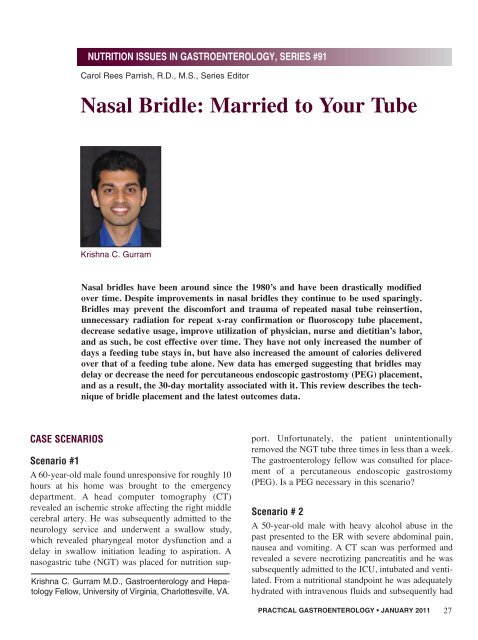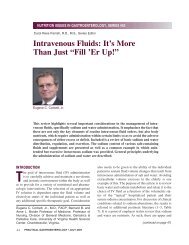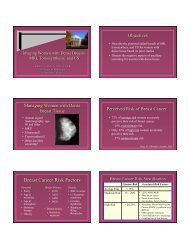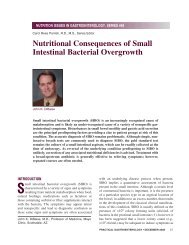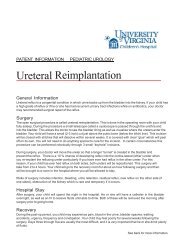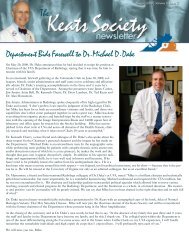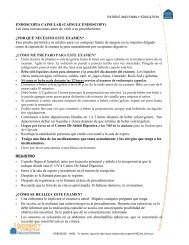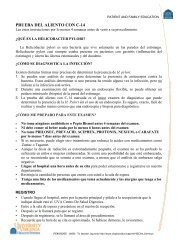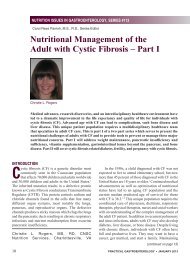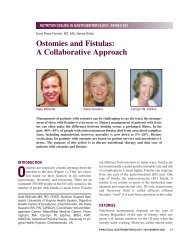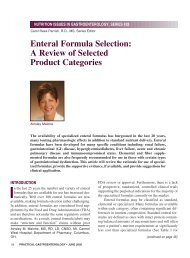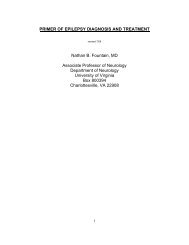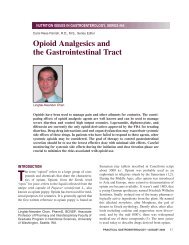Nasal Bridle: Married to Your Tube - Medicine - University of Virginia
Nasal Bridle: Married to Your Tube - Medicine - University of Virginia
Nasal Bridle: Married to Your Tube - Medicine - University of Virginia
Create successful ePaper yourself
Turn your PDF publications into a flip-book with our unique Google optimized e-Paper software.
CASE SCENARIOS<br />
NUTRITION ISSUES IN GASTROENTEROLOGY, SERIES #91<br />
Carol Rees Parrish, R.D., M.S., Series Edi<strong>to</strong>r<br />
<strong>Nasal</strong> <strong>Bridle</strong>: <strong>Married</strong> <strong>to</strong> <strong>Your</strong> <strong>Tube</strong><br />
Krishna C. Gurram<br />
<strong>Nasal</strong> bridles have been around since the 1980’s and have been drastically modified<br />
over time. Despite improvements in nasal bridles they continue <strong>to</strong> be used sparingly.<br />
<strong>Bridle</strong>s may prevent the discomfort and trauma <strong>of</strong> repeated nasal tube reinsertion,<br />
unnecessary radiation for repeat x-ray confirmation or fluoroscopy tube placement,<br />
decrease sedative usage, improve utilization <strong>of</strong> physician, nurse and dietitian’s labor,<br />
and as such, be cost effective over time. They have not only increased the number <strong>of</strong><br />
days a feeding tube stays in, but have also increased the amount <strong>of</strong> calories delivered<br />
over that <strong>of</strong> a feeding tube alone. New data has emerged suggesting that bridles may<br />
delay or decrease the need for percutaneous endoscopic gastros<strong>to</strong>my (PEG) placement,<br />
and as a result, the 30-day mortality associated with it. This review describes the technique<br />
<strong>of</strong> bridle placement and the latest outcomes data.<br />
Scenario #1<br />
A 60-year-old male found unresponsive for roughly 10<br />
hours at his home was brought <strong>to</strong> the emergency<br />
department. A head computer <strong>to</strong>mography (CT)<br />
revealed an ischemic stroke affecting the right middle<br />
cerebral artery. He was subsequently admitted <strong>to</strong> the<br />
neurology service and underwent a swallow study,<br />
which revealed pharyngeal mo<strong>to</strong>r dysfunction and a<br />
delay in swallow initiation leading <strong>to</strong> aspiration. A<br />
nasogastric tube (NGT) was placed for nutrition sup-<br />
Krishna C. Gurram M.D., Gastroenterology and Hepa<strong>to</strong>logy<br />
Fellow, <strong>University</strong> <strong>of</strong> <strong>Virginia</strong>, Charlottesville, VA.<br />
port. Unfortunately, the patient unintentionally<br />
removed the NGT tube three times in less than a week.<br />
The gastroenterology fellow was consulted for placement<br />
<strong>of</strong> a percutaneous endoscopic gastros<strong>to</strong>my<br />
(PEG). Is a PEG necessary in this scenario?<br />
Scenario # 2<br />
A 50-year-old male with heavy alcohol abuse in the<br />
past presented <strong>to</strong> the ER with severe abdominal pain,<br />
nausea and vomiting. A CT scan was performed and<br />
revealed a severe necrotizing pancreatitis and he was<br />
subsequently admitted <strong>to</strong> the ICU, intubated and ventilated.<br />
From a nutritional standpoint he was adequately<br />
hydrated with intravenous fluids and subsequently had<br />
PRACTICAL GASTROENTEROLOGY JANUARY 2011 27
<strong>Nasal</strong> <strong>Bridle</strong><br />
NUTRITION ISSUES IN GASTROENTEROLOGY, SERIES #91<br />
a nasojejunal tube (NJT) placed under fluoroscopy for<br />
nutrition. After the third day the NJ was displaced secondary<br />
<strong>to</strong> decreased adhesiveness <strong>of</strong> the tape due <strong>to</strong> his<br />
oily skin. After one day <strong>of</strong> no enteral feeding another<br />
NJT was placed under fluoroscopy. Due <strong>to</strong> his oily skin<br />
the tape continues <strong>to</strong> lose adhesiveness again. How can<br />
we prevent the NJT from displacing again?<br />
Scenario #3<br />
A 9-year-old girl with Toxic Epidermal Necrolysis Syndrome<br />
(TENS) was admitted with blisters affecting the<br />
face and mucous membranes <strong>of</strong> the mouth. She needed<br />
<strong>to</strong> be intubated and sedated for cleaning and dressing <strong>of</strong><br />
the affected areas. It was necessary <strong>to</strong> secure the tube<br />
without promoting further injury <strong>to</strong> the site. The use <strong>of</strong><br />
a nasal bridle was entertained! Could this work?<br />
INTRODUCTION<br />
Often the role <strong>of</strong> enteral nutrition (EN) in immune<br />
modulation and gut motility is under-appreciated<br />
(1). Nutritional support is a necessary intervention,<br />
not only in the critical care setting, but also for<br />
many general floor patients as well (2,3). Early initiation<br />
<strong>of</strong> nutrition enhances gut motility, prevents bacterial<br />
translocation and bacterial overgrowth (1). The<br />
impact <strong>of</strong> inadequate feeding in patients in the intensive<br />
care unit (ICU) has demonstrated an increased rate <strong>of</strong><br />
complications, especially infections (4). EN is preferred<br />
<strong>to</strong> parenteral nutrition (PN) due <strong>to</strong> the infectious risks as<br />
well as the increased cost associated with PN.<br />
Even though the enteral delivery <strong>of</strong> nutrients has<br />
improved, multiple fac<strong>to</strong>rs can hinder accomplishing<br />
adequate nutritional goals. In the ICU setting, cessation<br />
<strong>of</strong> enteral feedings have been attributed <strong>to</strong> procedures,<br />
increased gastric residual volume, diagnostic<br />
tests, nursing care, and tube displacement (2). In fact,<br />
sixty-six percent <strong>of</strong> the time tube displacement could<br />
have been avoided, and more than 50% <strong>of</strong> the time the<br />
rest <strong>of</strong> the above mentioned could have been avoided<br />
as well (5–7). On the general floor 60% <strong>of</strong> cases had<br />
suboptimal formula delivery as a result <strong>of</strong> inadvertent<br />
NGT extubation (3). Recurrent replacements <strong>of</strong> NGT’s<br />
are associated with multiple complications such as<br />
endotracheal intubation, pneumonia, pneumothorax,<br />
28<br />
PRACTICAL GASTROENTEROLOGY JANUARY 2011<br />
Table 1.<br />
Indications and Contraindications <strong>of</strong> <strong>Nasal</strong> <strong>Bridle</strong><br />
Indications<br />
Recurrent dislodgment <strong>of</strong> NGT/ NJT<br />
Any fluoroscopically placed NGT/NJT<br />
Facial burn victims with NGT/NJT<br />
His<strong>to</strong>ry <strong>of</strong> difficult NGT/ NJT placement<br />
Confused and agitated patients<br />
Oily skin with decreased adhesiveness <strong>of</strong> tape<br />
Contraindications<br />
Facial Trauma with nasal bone involvement<br />
Recurrent Epistaxis<br />
<strong>Nasal</strong> ulceration<br />
<strong>Nasal</strong> pain<br />
epistaxis and esophageal perforation (8,9). Other concerns<br />
include increased costs, unnecessary radiation<br />
exposure and an extra burden on those pr<strong>of</strong>essionals<br />
placing these tubes. The nasal bridle (NB) system was<br />
invented <strong>to</strong> prevent NGT displacement and augment<br />
delivery <strong>of</strong> enteral nutrition. There are several patient<br />
populations in which use <strong>of</strong> the NB are gaining<br />
momentum (see Table 1). <strong>Nasal</strong> bridling, while abhorrent<br />
<strong>to</strong> some, might deserve a second look.<br />
HISTORY<br />
The definition <strong>of</strong> a bridle is anything that can be used<br />
<strong>to</strong> secure both ends <strong>of</strong> an object by its center point. In<br />
our case the center point is the vomer bone (nasal septum)<br />
located in the anterior aspect <strong>of</strong> the skull (see Figure<br />
1). In 1980 the NB was first introduced, but was<br />
not readily accepted due <strong>to</strong> the complexity <strong>of</strong> placing<br />
the bridle (10). Further modifications were achieved in<br />
later years, but due <strong>to</strong> the type <strong>of</strong> bridle material and<br />
connection difficulties associated with EN, it was not<br />
eagerly received by many clinicians (11,12). In 1996,<br />
the tubing used for the manufacture <strong>of</strong> the NB was<br />
replaced by umbilical tape, which made it more<br />
acceptable than previous versions (13). Although the<br />
umbilical tape improved utility <strong>of</strong> preventing NGT<br />
extubation, placement was still technically challeng-<br />
(continued on page 30)
<strong>Nasal</strong> <strong>Bridle</strong><br />
NUTRITION ISSUES IN GASTROENTEROLOGY, SERIES #91<br />
(continued from page 28)<br />
Figure 1. Vomer Bone (red color).<br />
ing. Nevertheless, with the help <strong>of</strong> powerful magnets,<br />
the latest modification <strong>to</strong> the NB is now simple <strong>to</strong><br />
place and is slowly gaining wider acceptance (14). See<br />
Table 2, Figures 2 and 3 which demonstrates the placement<br />
<strong>of</strong> nasal bridle.<br />
OUTCOME DATA<br />
Dislodgement<br />
To assess the effectiveness <strong>of</strong> the NB, multiple studies<br />
have been undertaken comparing it <strong>to</strong> the usual tape<br />
(T) method (see Figure 4). Two different studies<br />
looked at NGT dislodgment and outcomes. Gunn et al.<br />
prospectively looked at the proportion and rate <strong>of</strong> tube<br />
dislodgment in the ICU setting. He determined a 26%<br />
absolute risk reduction favoring the NB (36% T vs.<br />
10% NB, p < 0.004) (15). Interestingly, a survival<br />
analysis on the NGT was performed; it demonstrated<br />
that a NB prevented dislodgment and consequently<br />
increased the tube survival (see Figure 5). A randomized<br />
controlled trial recently established the efficacy <strong>of</strong><br />
NB over tape (63% T vs. 18% NB dislodgment,<br />
p < 0.0001) (16). Similar findings have been confirmed<br />
in NJT displacement as well (see Figure 4)<br />
(17–19). Recently, Gupta et al. not only demonstrated<br />
a decrease in NGT dislodgment, but also showed a significant<br />
decrease in the amount <strong>of</strong> radiographic studies<br />
that were performed after the NB placement (20).<br />
NASAL BRIDLES AND CALORIC DELIVERY<br />
It has been demonstrated that NB decreases dislodgment<br />
<strong>of</strong> enteral feeding tubes, but more importantly, it<br />
30<br />
PRACTICAL GASTROENTEROLOGY JANUARY 2011<br />
Table 2.<br />
Procedure for <strong>Nasal</strong> <strong>Bridle</strong> Placement<br />
The placement <strong>of</strong> the NB has been modified over the<br />
years and is quite a simple process (see Figure 2 and 3).<br />
The package comes with a rigid blue probe, flexible white<br />
probe with umbilical tape/guide wire and clips corresponding<br />
<strong>to</strong> the size <strong>of</strong> the NGT.<br />
The first step is <strong>to</strong> inspect the nostril and mouth <strong>to</strong><br />
identify any causes <strong>of</strong> obstruction or deformities. The<br />
NB comes in different sizes from 5 french (F) <strong>to</strong> 18F<br />
and needs <strong>to</strong> correspond <strong>to</strong> the NGT size.<br />
The next step is <strong>to</strong> lubricate the rigid blue probe and<br />
insert it in<strong>to</strong> the nostril without the NGT up <strong>to</strong> the first<br />
rib on the probe.<br />
With the blue probe in position, place the flexible white<br />
probe in the opposite nostril.<br />
Withdraw the guidewire 1–2 cm and manipulate the<br />
white probe until a click or a feeling <strong>of</strong> the joining magnets<br />
occurs (Figure 3).<br />
After confirmation <strong>of</strong> the joined magnets by the previous<br />
technique, remove the guidewire completely.<br />
Slowly withdraw the blue probe with the white probe<br />
attached at the other end. The tape will follow the white<br />
probe around the vomer bone (nasal septum) as it<br />
comes out through the opposite nostril. The tape will<br />
be protruding out <strong>of</strong> both nostrils at this point. The<br />
umbilical tape attached <strong>to</strong> the white probe is cut leaving<br />
only the tape in the nostrils.<br />
After the NGT is placed, it is then put in the clip channel<br />
with both strands <strong>of</strong> tape at the hinge <strong>of</strong> the clip.<br />
After the clip has been closed, the tape is cut and tied.<br />
It is important <strong>to</strong> keep in mind that if a patient pulls<br />
hard enough on the NGT with NB, the NGT stretches<br />
and decreases in size and consequently slips out <strong>of</strong><br />
the NB.<br />
For further information on placement please visit<br />
http://www.youtube.com/appliedmedical<br />
increases caloric delivery <strong>to</strong> the patient. Cheung et al.<br />
performed a retrospective review <strong>of</strong> all patients who<br />
underwent NB and looked at 7 day pre-NB and 30 day<br />
post-NB caloric delivery (21). He included 48 patients<br />
referred for NB placement with an average <strong>of</strong> 2.3 NGT<br />
displacements. Pre-NB insertion less than half <strong>of</strong> the<br />
caloric requirements were met in 67.3% <strong>of</strong> patients.<br />
Post-NB this percentage dropped <strong>to</strong> 13.4%. It was also
Figure 2. <strong>Nasal</strong> <strong>Bridle</strong> Placement.<br />
noted that one-third <strong>of</strong> these patients required more<br />
than one nasal bridle placement (mean 1.4 reinsertions)<br />
due <strong>to</strong> either intentional removal by the patient<br />
or NGT blockage.<br />
Donaldson et al, prospectively looked at the role <strong>of</strong><br />
NB insertion and the outcomes associated with it (22).<br />
There were a <strong>to</strong>tal <strong>of</strong> 96 patients who underwent NB<br />
placement for various reasons, the most common<br />
being stroke and dementia. Prior <strong>to</strong> NB placement the<br />
caloric goals received were only an average <strong>of</strong> 20%;<br />
after NB placement it increased <strong>to</strong> 98%. Delivery <strong>of</strong><br />
98% <strong>of</strong> calorie goal is quite optimistic and a lot more<br />
than is typically reported in enteral feeding studies;<br />
details <strong>of</strong> how many NGTs were placed prior <strong>to</strong> the<br />
NB, or the reason for their initial low caloric delivery<br />
was not described.<br />
Recently, a randomized controlled trial aimed at<br />
identifying caloric delivery with NB was performed<br />
(16). Eighty ICU patients were randomized <strong>to</strong> receive a<br />
NJT with either NB or routine tape. In the study, the NB<br />
group reached a higher caloric goal than the adhesive<br />
tape group (78% vs. 62%, p = 0.016). The increased<br />
nutrition delivery was mostly due <strong>to</strong> the decreased dislodgment<br />
rate (18% vs. 63%, p < 0.0001). There were<br />
5 cases <strong>of</strong> mild epistaxis upon insertion and 4 cases <strong>of</strong><br />
superficial nasal ulceration without any major complications.<br />
Consistently, NB is associated with a higher<br />
percentage <strong>of</strong> calorie goals being reached (16, 21–23).<br />
<strong>Nasal</strong> <strong>Bridle</strong><br />
NUTRITION ISSUES IN GASTROENTEROLOGY, SERIES #91<br />
Figure 3. Magnetic attachment model.<br />
DO NASAL BRIDLES HELP PREVENT<br />
UNNECESSARY PEG PLACEMENT?<br />
In one study, dysphagic patients who were unable <strong>to</strong><br />
have continuous NG feeding (the authors did not<br />
described why) were referred for PEG placement (23).<br />
They were divided in<strong>to</strong> 2 groups; the first group were<br />
stroke patients referred < 28-day post event (n = 14);<br />
the second group was > 28 days post event (n = 7). The<br />
first group underwent NGT with bridle and the second<br />
group underwent PEG placement. Fourteen patients<br />
had NB for median <strong>of</strong> 15 days and therefore prevented<br />
PEG placement in 8 patients (4 recovered, 4 died)<br />
PRACTICAL GASTROENTEROLOGY JANUARY 2011 31
<strong>Nasal</strong> <strong>Bridle</strong><br />
NUTRITION ISSUES IN GASTROENTEROLOGY, SERIES #91<br />
Figure 4. <strong>Tube</strong> displacement outcomes between Tape (T) and <strong>Nasal</strong> <strong>Bridle</strong> (NB). *Studies with Nasojejunal <strong>Tube</strong>s (NJT) (15–19).<br />
while 6 went on <strong>to</strong> receive a PEG (4 died). Interestingly,<br />
3 out <strong>of</strong> 4 patients in the NB group died <strong>of</strong> bronchopneumonia,<br />
while only one <strong>of</strong> the 2 out <strong>of</strong> the 4 in<br />
PEG deaths were related <strong>to</strong> pneumonia (series edi<strong>to</strong>r’s<br />
note: one might question whether early PEG placement<br />
might have decreased the acquisition <strong>of</strong> pneumonia).<br />
At the 3 month follow-up, 5 had normal<br />
swallowing, 8 had died, and 1 was still using the PEG.<br />
NB might have prevented 56% (8/14) <strong>of</strong> people from<br />
undergoing a PEG. Four did undergo PEGs and died<br />
from pneumonias, renal failure, or myocardial infarction.<br />
Similarly, in other studies NB decreased PEG<br />
placement > 50% <strong>of</strong> the time (24,25).<br />
Since PEG placement by itself is associated with<br />
an overall increased mortality and morbidity, the next<br />
question is can NB <strong>of</strong>fset these complications (26)?<br />
The FOOD Trial was a randomized controlled trial <strong>of</strong><br />
321 patients <strong>to</strong> undergo either PEG or NGT feeding<br />
(27). The primary outcomes were death or poor outcomes<br />
at 6 months. There was a borderline significance<br />
in absolute risk <strong>of</strong> death or poor outcome <strong>of</strong><br />
PEG at 6 months with 7.8% higher likelihood<br />
(p = 0.05). Unfortunately, the study was s<strong>to</strong>pped early<br />
due <strong>to</strong> lack <strong>of</strong> funding. This study has been critiqued<br />
32<br />
PRACTICAL GASTROENTEROLOGY JANUARY 2011<br />
for its selection bias and probably does not clearly<br />
answer the question it was set forth <strong>to</strong> answer. Since<br />
the study was not a true randomization and the outcome<br />
measure <strong>of</strong> poor outcomes was performed as a<br />
single assessment 6 months after enrollment, there are<br />
<strong>to</strong>o many variables not taken in<strong>to</strong> consideration in<br />
order <strong>to</strong> identify true outcomes. Keeping the previous<br />
study in mind, Donaldson et al. compared post-PEG 30<br />
day mortality pre and post NB introduction and found<br />
a 10% absolute risk reduction (22). A similar study by<br />
Johns<strong>to</strong>n et al. demonstrated the PEG 30 day mortality<br />
decreased from 28% <strong>to</strong> 11% (p < 0.01) with the introduction<br />
<strong>of</strong> NB (25). The abstract did not fully explain<br />
the cause <strong>of</strong> the decreased motility, but it was thought<br />
that the NB <strong>of</strong>fered an average <strong>of</strong> 10 days <strong>of</strong> adequate<br />
nutrition prior <strong>to</strong> PEG placement and allowed a better<br />
selection <strong>of</strong> patients for the PEG.<br />
COST SAVINGS ASSOCIATED WITH BRIDLES<br />
Seder et al. evaluated the cost effectiveness <strong>of</strong> the NB<br />
and described $4038 savings over a three month period<br />
(19). Of note, the cost <strong>of</strong> material and labor required <strong>to</strong><br />
place 62 bridles was reported as only $372 ($6/patient),
<strong>Nasal</strong> <strong>Bridle</strong><br />
NUTRITION ISSUES IN GASTROENTEROLOGY, SERIES #91<br />
Figure 5. Survival analysis on Nasogastric <strong>Tube</strong> (NGT) comparing <strong>Nasal</strong> <strong>Bridle</strong> (Dashed line - - - - -) and Tape (Continuous<br />
Line ———) (15).<br />
suggesting this was hospital cost vs. patient cost. They<br />
did take in<strong>to</strong> consideration the role <strong>of</strong> fluoroscopic<br />
placement ($875) and bedside replacement ($190) as<br />
well and predicted that 2 would be performed under<br />
fluoroscopy and 14 bedside procedures. The figures are<br />
extremely low as the cost <strong>of</strong> the NB itself is around<br />
$80. Additionally, the numbers <strong>of</strong> NGT used in the NB<br />
group (67) compared <strong>to</strong> tape (66) were similar as it was<br />
a crossover trial (16). Some tape patients crossed over<br />
<strong>to</strong> the NB group while unsuccessful attempt at postpyloric<br />
tube placement in the NB group required a second<br />
tube insertion. However, when positioned properly the<br />
non-crossover tubes were 15% less in the NB group (54<br />
NB vs. 62 tape). Nevertheless, it might be cost effective<br />
if one considers that PEG placement could potentially<br />
be deferred.<br />
Some studies have demonstrated minor complications<br />
associated with the NB (15,16,18,19). These<br />
include epistaxis and nasal ulcerations and are usually<br />
mild and infrequent. In one study, 26% <strong>of</strong> patients<br />
(n = 4) had minor epistaxis at time <strong>of</strong> insertion, but no<br />
other complications thereafter (28). One study demonstrated<br />
a decrease in complications with the utilization<br />
<strong>of</strong> umbilical tape compared <strong>to</strong> the bulky red rubber<br />
tube (16). Although the studies were not powered <strong>to</strong><br />
look at the complications, very few complications<br />
have occurred that required removal. In the latest study<br />
by Seder et al., <strong>of</strong> the 40 patients with NB, four<br />
patients had nasal ulceration, but only two required<br />
NB removal (< 5% removal) (16).<br />
Two other cases <strong>of</strong> NB use have been reported in<br />
the pediatric age group (29,30). The first case was a<br />
patient with TENS that had mucous membrane<br />
involvement; the other was a patient with Type 1<br />
spinal muscular atrophy with irritation from tape.<br />
CONCLUSION<br />
Overall the bridle appears <strong>to</strong> be an efficient way <strong>of</strong> preventing<br />
recurrent NGT/NJT displacements while promoting<br />
higher caloric delivery than NGT alone. A NB<br />
also prevents the discomfort and trauma <strong>of</strong> repeated<br />
nasal tube reinsertion, unnecessary radiation for repeat<br />
x-ray confirmation or fluoro tube placement, decrease<br />
sedative usage, improve utilization <strong>of</strong> physician and<br />
nurse’s labor, and ultimately be cost effective over<br />
time. The use <strong>of</strong> a NB may potentially decrease the<br />
need for early PEG placement and thereby decrease<br />
PRACTICAL GASTROENTEROLOGY JANUARY 2011 33
<strong>Nasal</strong> <strong>Bridle</strong><br />
NUTRITION ISSUES IN GASTROENTEROLOGY, SERIES #91<br />
the early 30-day and possibly 6 month mortality or<br />
poor outcomes. The bridle has many promising features<br />
and deserves a closer look. n<br />
References<br />
1. Jabbar A, Chang WK, Dryden GW, et al. Gut immunology and<br />
the differential response <strong>to</strong> feeding and starvation. Nutr Clin<br />
Pract 2003;18:461-82.<br />
2. McClave SA, Sex<strong>to</strong>n LK, Spain DA, et al. Enteral tube feeding in<br />
the intensive care unit: fac<strong>to</strong>rs impeding adequate delivery. Crit<br />
Care Med 1999;27:1252-6.<br />
3. Whelan K, Hill L, Preedy VR, et al. Formula delivery in patients<br />
receiving enteral tube feeding on general hospital wards: the<br />
impact <strong>of</strong> nasogastric extubation and diarrhea. Nutrition<br />
2006;22:1025-31.<br />
4. Villet S, Chiolero RL, Bollmann MD, et al. Negative impact <strong>of</strong><br />
hypocaloric feeding and energy balance on clinical outcome in<br />
ICU patients. Clin Nutr 2005;24:502-9.<br />
5. Rice TW, Swope T, Bozeman S, et al. Variation in enteral nutrition<br />
delivery in mechanically ventilated patients. Nutrition<br />
2005;21:786-92.<br />
6. Roberts SR B. A multicenter evaluation <strong>of</strong> nasogastric enteral<br />
feedings in critically ill patients [Abstract]. J Am Diet Assoc<br />
2009:109: A-34.<br />
7. Van Den Broek PW, Rasmussen-Conrad EL, Naber AH, et al.<br />
What you think is not what they get: significant discrepancies<br />
between prescribed and administered doses <strong>of</strong> tube feeding. Br J<br />
Nutr 2009;101:68-71.<br />
8. Durai R, Venkatraman R, Ng PC. Nasogastric tubes. 2: Risks and<br />
guidance on avoiding and dealing with complications. Nurs<br />
Times 2009;105:14-6.<br />
9. McWey RE, Curry NS, Schabel SI, et al. Complications <strong>of</strong><br />
nasoenteric feeding tubes. Am J Surg 1988;155:253-7.<br />
10. Armstrong C, Luther W, Sykes T. A Technique for preventing<br />
extubation <strong>of</strong> feeding tubes: “The bridle.” Abstract. JPEN J Parenter<br />
Enteral Nutr 1980;3:603.<br />
11. Barrocas A. The bridle: Increasing the use <strong>of</strong> nasoenteric feedings.<br />
Nutr Supp Serv 1982;2:8-10.<br />
12. Levensen R, Dyson A, Turner WW. Feeding tube anchor. Nutr<br />
Supp Serv 1985;5:40-42.<br />
13. Popovich MJ, Lockrem JD, Zivot JB. <strong>Nasal</strong> bridle revisited: an<br />
improvement in the technique <strong>to</strong> prevent unintentional removal <strong>of</strong><br />
small-bore nasoenteric feeding tubes. Crit Care Med<br />
1996;24:429-31.<br />
14. Popovich MJ. The bridle: path <strong>to</strong> improved enteral nutrition efficiency.<br />
Crit Care Med 2010;38:984-5.<br />
15. Gunn SR, Early BJ, Zenati MS, et al. Use <strong>of</strong> a nasal bridle prevents<br />
accidental nasoenteral feeding tube removal. JPEN J Parenter<br />
Enteral Nutr 2009;33:50-4.<br />
16. Seder CW, S<strong>to</strong>ckdale W, Hale L, et al. <strong>Nasal</strong> bridling decreases<br />
feeding tube dislodgment and may increase caloric intake in the<br />
surgical intensive care unit: a randomized, controlled trial. Crit<br />
Care Med 2010;38:797-801.<br />
17. Brandt CP, Mittendorf EA. Endoscopic placement <strong>of</strong> nasojejunal<br />
feeding tubes in ICU patients. Surg Endosc 1999;13:1211-4.<br />
18. Hegazi R, Rolniak S, Centa P, et al. Effects <strong>of</strong> a <strong>Nasal</strong> <strong>Tube</strong><br />
Retention Device (AMT <strong>Bridle</strong>) on Frequency <strong>of</strong> Nasojejunal<br />
Feeding <strong>Tube</strong> Displacement. Nutrition Practice Poster, 2008.<br />
19. Seder CW, Janczyk R. The routine bridling <strong>of</strong> nasojejunal tubes<br />
is a safe and effective method <strong>of</strong> reducing dislodgement in the<br />
intensive care unit. Nutr Clin Pract 2008;23:651-4.<br />
20. Gupta PK Fitchett J, Simmons J, et al. Efficacy <strong>of</strong> <strong>Nasal</strong> <strong>Bridle</strong>s<br />
in Preventing Nasogastric <strong>Tube</strong> Displacement. The Royal Berkshire<br />
Experience. Gastroenterology 2010:S234: S1350.<br />
34<br />
PRACTICAL GASTROENTEROLOGY JANUARY 2011<br />
21. Cheung KT, Donaldson E, Earley T, et al. Use <strong>of</strong> <strong>Nasal</strong> <strong>Bridle</strong>s<br />
<strong>to</strong> Secure Nasogastric <strong>Tube</strong>s Improves Delivery <strong>of</strong> Enteral Nutrition<br />
in at-Risk Patients. 2009 Annual Meeting <strong>of</strong> the British Society<br />
<strong>of</strong> Gastroenterology 2009.<br />
22. Donaldson E, Earley T, Sheilds PL. The <strong>Nasal</strong> <strong>Bridle</strong> - Its Place<br />
Within An Integrated Nutrition Service: A Prospective Audit Of<br />
One Year’s Data. Gut 2007;56:A137.<br />
23. Anderson MR, O’Connor M, Mayer P, et al. The nasal loop provides<br />
an alternative <strong>to</strong> percutaneous endoscopic gastros<strong>to</strong>my in<br />
high-risk dysphagic stroke patients. Clin Nutr 2004;23:501-6.<br />
24. Benell J, Black S, Murray C, Moore K. The <strong>Nasal</strong> <strong>Bridle</strong> Effectively<br />
Secures Nasogastric Feeding <strong>Tube</strong>s and Avoids unnecessary<br />
Invasive Enteral and Parenteral Nutrition. 2009 Annual<br />
Meeting <strong>of</strong> the British Society <strong>of</strong> Gastroenterology, 2009.<br />
25. Johns<strong>to</strong>n RD, O’Dell L, Patrick M, et al. Outcome <strong>of</strong> Patients fed<br />
via a nasogastric tube retained with a bridle loop: do bridle loops<br />
reduce the requirement for percutaneous endoscopic gastros<strong>to</strong>my<br />
insertion and 30-day mortality? Proceedings <strong>of</strong> the Nutrition<br />
Society (2008). Malnutrition Matters, Joint BAPEN and Nutrition<br />
Society Meeting, 27-28 November 2007, 2008.<br />
26. Shah RD, Tariq N, Shanley C, et al. Peri<strong>to</strong>nitis from peg tube<br />
insertion in surgical intensive care unit patients: identification <strong>of</strong><br />
risk fac<strong>to</strong>rs and clinical outcomes. Surg Endosc 2009;23:2580-6.<br />
27. Dennis MS, Lewis SC, Warlow C. Effect <strong>of</strong> timing and method<br />
<strong>of</strong> enteral tube feeding for dysphagic stroke patients (FOOD): a<br />
multicentre randomized controlled trial. Lancet 2005;365:764-72.<br />
28. Power S. The nasal bridle: an innovative approach <strong>to</strong> prevent<br />
accidental removal <strong>of</strong> nasoenteric feeding tubes [Abstract]. Nutr<br />
Clin Pract 2009;24:126.<br />
29. Rooney KD, Poolacherla R. Use <strong>of</strong> the nasal bridle <strong>to</strong> secure fixation<br />
<strong>of</strong> an endotracheal tube in a child with facial blistering secondary<br />
<strong>to</strong> <strong>to</strong>xic epidermal necrolysis. Burns 2009.<br />
30. Weber MD, Slusher T. A nasal bridle for securing nasotracheal<br />
tubes. Anesth Analg 2004;99:629.<br />
PRACTICAL<br />
GASTROENTEROLOGY<br />
R E P R I N T S<br />
Practical Gastroenterology<br />
reprints are valuable, authoritative,<br />
and informative. Special rates<br />
are available for quantities<br />
<strong>of</strong> 100 or more.<br />
For further details on rates<br />
or <strong>to</strong> place an order:<br />
visit our website at:<br />
www.practicalgastro.com


